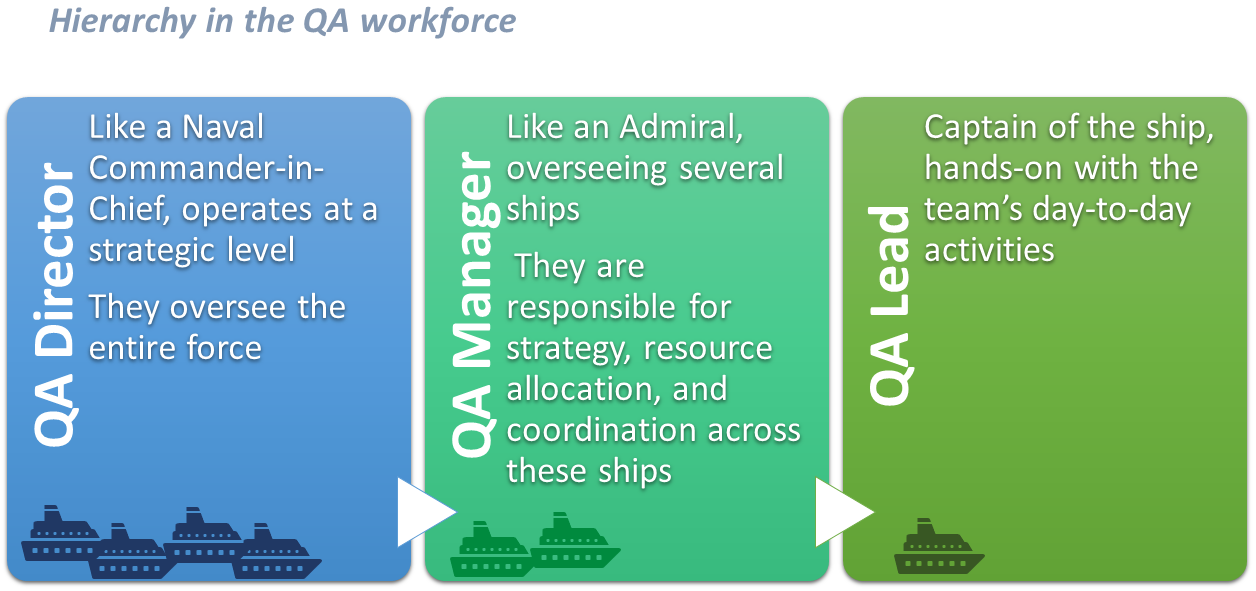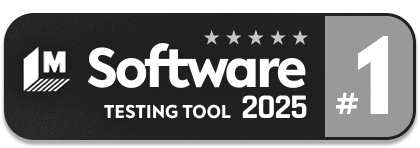QA Lead Job Description
|
|
You can think of a QA Lead as the captain of a ship. Just as a captain navigates a ship through the vast and sometimes tumultuous seas, ensuring the crew’s safety and the vessel’s integrity, a QA Lead navigates the complex process of software testing.
The QA Lead is hands-on and deeply involved in the day-to-day activities. They are like the captain on the deck, steering the ship, navigating through immediate obstacles, and making tactical decisions. They directly interact with the crew, in this case, the QA team, understand their strengths and weaknesses, assign specific tasks, and ensure the ship, the software product, is on the right course.
If you aspire to be a QA Lead or are already in the role and looking to understand the role better, read on further. A note before you understand this job – the expectations may vary from company to company depending on their requirements. However, the below content will help you prepare at a general level for this role.
Responsibilities of a QA Lead
A lot lies on the shoulders of QA Leads as they guide and oversee the testing team. Let’s look at the duties that are a QA Lead’s prerogative.
Test planning and strategy
If you are a QA Lead, you need to chalk out a path of action for your team for every project. You can achieve this by developing and implementing testing strategies and test plans to ensure software quality. Here is a test strategy template to refer to.
This involves defining the scope and objectives of testing activities and allocating tasks to team members, identifying test requirements from specifications, mapping test case requirements, and designing test coverage plans.
Test development and execution
You may not have to create test cases personally, but you surely need to oversee the test development and subsequent execution. This involves both manual and automated test cases. If bugs arise during the testing phase, your input will be required in prioritizing and driving resolutions of the bugs. Read a good article about latent defects.
Team leadership and management
A good team leader is attuned to the team and is aware of their strengths and weaknesses. As a QA Lead, you need to constantly be in touch with your team, lead, mentor, and manage them. Especially during challenging projects or sticky situations, your input, even action, will be required to help the team weather the storm.
As a leader, you are also expected to ensure adherence to quality standards and procedures within your team.
Review test documentation
More often than not, you will not be the one writing various test documentation, and hence, you need to review them. This involves test plans, test cases, and test reports that are generated by the team during various phases of the project. This task is critical as these documents are going to be reviewed and circulated across teams and among management. You need to make sure that what goes outside the team is of good quality and can be understood by stakeholders.
Quality metrics and reporting
As a QA Lead, you need to monitor, measure, and report on test progress, test results, and product quality. Create quality metrics to track progress tangibly. Based on tools used in your company, you can adopt tracking dashboards like JIRA to generate sharable and comprehensive reports of testing activities and identified bugs.
Process improvement and development of standards
You can make a difference in your role by developing and implementing quality assurance standards and processes. You can achieve this by learning about the general trends in your company with respect to product quality, speaking to senior testers in your team or other teams with experience, and using your own knowledge and observations to come up with better standards. Read how to perform QA in an efficient manner.
Stakeholder communication and collaboration
Quite often, you will be involved in meetings where you will be representing the QA aspect of the product. This will mean that you will be the face of your team that interfaces with developers, business analysts, and user representatives regarding testing statuses, project progress, and issue resolution.
Risk management
A good leader identifies risks and prepares for them. Identify project risks during the planning phase and work on mitigating them. This will help ensure that deliverables meet the functional, performance, and quality requirements on time. Here is an article about risk-based testing.
Tool and technology adoption
Staying current with new testing tools and test strategies will help boost your team’s efficiency. Regularly evaluate and implement suitable tools and technologies to improve testing efficiency and effectiveness.
For example, modern generative AI-based test automation tools like testRigor are available that make testing across multiple platforms easy through plain English statements. Such tools not only make test creation easier but also cut down the hassle of test maintenance.
However, you may not be able to implement them directly as different companies have different standards of operation, and you might require necessary approval from higher authorities. Another word of caution is to consider your team’s acumen before jumping into greener pastures regarding tools and trends. Read here how to start test automation.
Skills every QA Lead should possess
Here’s a compilation of skills that you should work on as a QA Lead.
Technical skills
As a QA Lead, you should understand software development, automation processes, testing methodologies, and QA tools. Familiarity with modern concepts like Agile frameworks, AI-based tools, and various forms of testing will help.
Develop experience in writing clear, concise, and comprehensive test plans and cases, along with hands-on experience with white box and black box testing and automated testing tools. Read about Black-box vs Gray-box vs White-box testing.
Leadership skills
As you might have guessed, a QA Lead is a leader first and foremost to the team. Strong leadership skills with the ability to motivate and guide team members, along with excellent organizational skills, including the ability to manage multiple tasks simultaneously, will be needed.
You will also need skills like learning to give feedback, conflict management, and understanding business trends, among others.
Communication skills
A QA Lead needs to develop strong communication skills with the ability to clearly articulate issues and work collaboratively with development teams to resolve them.
Analytical skills
Strong analytical skills with the ability to understand complex systems and logic will help you advance your career. Sharpen your problem-solving and risk-management skills to ensure you can ride the wave and not crash with it.
Tips to be a better QA Lead
You can improve your impact as a QA Lead by trying these tips.
Understand your team’s dynamics
This is good practice in general to know your team on a professional level. To achieve the best results, you need to know the strengths and weaknesses of each team member, how they work together, their views on processes and ideas to improve the same, and motivation levels. This information will help you tweak your leadership style as well.
Identify your leadership style
Just like you plan to understand your team’s profile, understand your own strengths, weaknesses, and, ultimately, your leadership style. Based on that, you can effectively interact, motivate, and get tasks done from your team. For example, if you are good at handling interpersonal relationships, then use that skill when assigning tasks.
Review the feedback you received
Try not to view feedback as criticism. Remember that feedback can provide opportunities to better your performance. So whether a subordinate or a superior gives feedback, just assess it objectively and then see if it is applicable to you or not.
Review the team’s performance and give feedback
Regularly review the team’s work and see if they are delivering up to the mark. Based on your analysis, connect with your team members individually to give both positive and negative feedback.
Convey findings in the form of business value
This is an exciting pointer for a QA Lead. You will find yourself speaking to a lot of business stakeholders like your superiors, higher management, and clients, using business value to explain to them how the testing findings will impact the client.
For example, if performance issues were identified during testing, you can explain this to the client. Try to highlight that when many users try to access the application, it faces frequent crashes, eventually frustrating the user. You can explain how it will impact their business.
Be ready to get your hands dirty when needed
Remember that a leader who leads by example is the best kind of leader. If there’s a new tool you want to introduce into the process or you want to set some standards with test script creation, then you should show them how to do it. If needed, be involved during the learning curve to make sure that they do it right.
Regular sync-up meetings with the team
Keep a finger on the pulse; you should know what’s happening within the team. This will also help you assess how the team is performing and whether new processes are working out.
Difference between QA Lead, QA Manager, and QA Director
Though all of these roles are leadership roles, they involve different degrees of responsibility and involvement with various teams. A QA Lead will not be as involved with the management as a QA manager or a QA Director will be. Likewise, only a QA Lead will be well-versed in the team’s happenings, as Managers and Directors don’t usually interact directly with team members.
Building on the ship analogy from the start of this article, here’s a simple way to understand how these roles differ.

Wrapping up
You might have understood how versatile this role can be from the above article. A QA Lead is pivotal in ensuring that the software product meets the highest quality standards before it’s delivered to the customer. The responsibilities vary slightly depending on the company’s size, sector, and the complexity of the software being developed.
| Achieve More Than 90% Test Automation | |
| Step by Step Walkthroughs and Help | |
| 14 Day Free Trial, Cancel Anytime |








